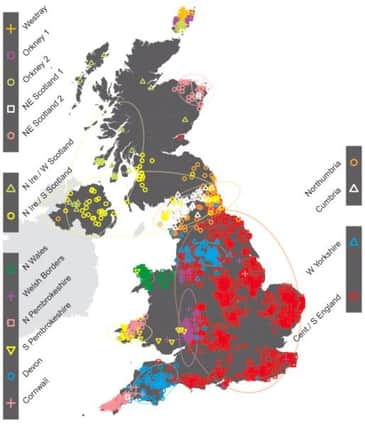Tell-tale DNA scotches myths over Norsemen


But it seems our image of the wild men from the North may have been mistaken for a number of centuries.
A new study suggests that while they frequently engaged in a spot of pillaging, reports of their sex-mad nature have been greatly exaggerated.
Advertisement
Hide AdAdvertisement
Hide AdThe lack of Viking genes found in thousands of modern-day DNA samples from the UK, continental Europe and Scandinavia dispels the myth that the rape of country women was a typical consequence of a Norse invasion, according to scientists.
Even in Orkney, which was a part of Norway from 875 to 1472, the Vikings contributed only about 25 per cent of the current gene pool, according to research from Oxford University and the Wellcome Trust’s centre for genetics.
Their report, published in the journal Nature, said: “While many of the historical migration events leave signals in our data, they have had a smaller effect on the genetic composition of UK populations than has sometimes been argued.
“In particular, we see no clear genetic evidence of the Danish Viking occupation and control of a large part of England suggesting a relatively limited input of DNA from the Danish Vikings and subsequent mixing with nearby regions, and clear evidence for only a minority Norse contribution.”
Advertisement
Hide AdAdvertisement
Hide AdThe Vikings, from Norway, Sweden and Denmark, carried out extensive raids and occupations across wide areas of northern and central Europe between the eighth and late 11th centuries.
Danish Vikings in particular took over large parts of England, eventually settling in an a region stretching from Essex to County Durham.
The study looked for tell-tale changes in the genetic code in the DNA of 2,039 people from the UK, which were then compared with similar genetic data from more than 6,000 individuals from 10 countries across Europe.
Findings support previous research which has suggested Vikings were family-orientated. Contrary to popular belief, significant numbers of women travelled on the longboats – and the examination of 45 Viking skulls found that they played a role in establishing UK settlements.
Advertisement
Hide AdAdvertisement
Hide AdProfessor Peter Donnelly,of the Wellcome Trust, said: “Genetics tells us the story of what happens to the masses.
“There were a large numbers of people in those areas of Britain by the time the Danish Vikings came so to have a substantial impact on the genetics there would need to be very large numbers of them leaving DNA for subsequent generations.”